
- 使用PHP开发Android应用程序技术介绍
- 浅析Android手机卫士sim卡绑定
- Android编程开发之EditText中inputType属性小结
- Android AutoCompleteTextView控件基本用法示例
- Android仿UC浏览器左右上下滚动功能
- 学习Android Material Design(RecyclerView代替ListView)
- Android有效获取状态栏(StatusBar)高度的方法
- Android开发 -- 状态栏通知Notification、NotificationManager详解
- Android仿微信发表说说实现拍照、多图上传功能
- Android仿微信朋友圈实现滚动条下拉反弹效果
- android 退出程序解决内存释放的问题
- C#之Android手机App开发
- Android LayoutInflater中 Inflate()方法应用
- Android Webview添加网页加载进度条实例详解
- 详解Android TableLayout表格布局
- Android TabWidget切换卡的实现应用
- Android实现千变万化的ViewPager切换动画
- Android开发笔记之探秘WebView
- Android编程之截屏实现方法(包括scrollview与listview)
- 浅析Android 的 MediaPlayer类
- Android编程实现基于局域网udp广播自动建立socket连接的方法
- Android自定义View实现BMI指数条
- Android实现View滑动的几种方式
- android自定义RadioGroup可以添加多种布局的实现方法
- android 通过向viewpage中添加listview来完成滑动效果(类似于qq滑动界面)
- 图解Windows环境下Android Studio安装和使用教程
- Android编程中EditText限制文字输入的方法
- Android App仿QQ制作Material Design风格沉浸式状态栏
- Android下拉刷新上拉加载更多左滑动删除
- Android可循环显示图像的Android Gallery组件用法实例
Android三种网络通讯方式及Android的网络通讯机制
Android平台有三种网络接口可以使用,他们分别是:java.net.*(标准Java接口)、Org.apache接口和Android.net.*(Android网络接口)。下面分别介绍这些接口的功能和作用。
1.标准Java接口
java.net.*提供与联网有关的类,包括流、数据包套接字(socket)、Internet协议、常见Http处理等。比如:创建URL,以及URLConnection/HttpURLConnection对象、设置链接参数、链接到服务器、向服务器写数据、从服务器读取数据等通信。这些在Java网络编程中均有涉及,我们看一个简单的socket编程,实现服务器回发客户端信息。
下面用个例子来说明:
A、客户端:
新建Android项目工程:SocketForAndroid(这个随意起名字了吧,我是以这个建立的!)
下面是main_activity.xml的代码:
<?xml version="1.0" encoding="utf-8"?> <LinearLayout xmlns:android="http://schemas.android.com/apk/res/android" android:layout_width="fill_parent" android:layout_height="fill_parent" android:orientation="vertical"> <TextView android:layout_width="fill_parent" android:layout_height="wrap_content" android:text="@string/hello" /> <EditText android:id="@+id/message" android:layout_width="match_parent" android:layout_height="wrap_content" android:hint="@string/hint" /> <Button android:id="@+id/send" android:layout_width="fill_parent" android:layout_height="wrap_content" android:text="@string/send" /> </LinearLayout>
MainActivity.java的代码入下:
package com.yaowen.socketforandroid;
import android.os.Bundle;
import android.support.v7.app.AppCompatActivity;
import android.view.View;
import android.widget.Button;
import android.widget.EditText;
import java.io.BufferedReader;
import java.io.BufferedWriter;
import java.io.IOException;
import java.io.InputStreamReader;
import java.io.OutputStreamWriter;
import java.io.PrintWriter;
import java.net.Socket;
public class MainActivity extends AppCompatActivity {
private EditText message;
private Button send;
@Override
protected void onCreate(Bundle savedInstanceState) {
super.onCreate(savedInstanceState);
setContentView(R.layout.activity_main);
//初始化两个UI控件
message = (EditText) findViewById(R.id.message);
send = (Button) findViewById(R.id.send);
//设置发送按钮的点击事件响应
send.setOnClickListener(new View.OnClickListener() {
@Override
public void onClick(View v) {
Socket socket = null;
//获取message输入框里的输入的内容
String msg = message.getText().toString() + "\r\n";
try {
//这里必须是192.168.3.200,不可以是localhost或者127.0.0.1
socket = new Socket("192.168.3.200", 18888);
PrintWriter out = new PrintWriter(
new BufferedWriter(
new OutputStreamWriter(
socket.getOutputStream()
)
), true);
//发送消息
out.println(msg);
//接收数据
BufferedReader in = new BufferedReader(
new InputStreamReader(
socket.getInputStream()
)
);
//读取接收的数据
String msg_in = in.readLine();
if (null != msg_in) {
message.setText(msg_in);
System.out.println(msg_in);
} else {
message.setText("接收的数据有误!");
}
//关闭各种流
out.close();
in.close();
} catch (IOException e) {
e.printStackTrace();
} finally {
try {
if (null != socket) {
//socket不为空时,最后记得要把socket关闭
socket.close();
}
} catch (IOException e) {
e.printStackTrace();
}
}
}
});
}
}
最后别忘记添加访问网络权限:
<uses-permission android:name="android.permission.INTERNET" />
B、服务端:
package service;
import java.io.BufferedReader;
import java.io.BufferedWriter;
import java.io.IOException;
import java.io.InputStreamReader;
import java.io.OutputStreamWriter;
import java.io.PrintWriter;
import java.net.ServerSocket;
import java.net.Socket;
public class ServerAndroid implements Runnable {
@Override
public void run() {
Socket socket = null;
try {
ServerSocket server = new ServerSocket(18888);
// 循环监听客户端链接请求
while (true) {
System.out.println("start...");
// 接收请求
socket = server.accept();
System.out.println("accept...");
// 接收客户端消息
BufferedReader in = new BufferedReader(new InputStreamReader(socket.getInputStream()));
String message = in.readLine();
System.out.println(message);
// 发送消息,向客户端
PrintWriter out = new PrintWriter(new BufferedWriter(new OutputStreamWriter(socket.getOutputStream())),
true);
out.println("Server:" + message);
// 关闭流
in.close();
out.close();
}
} catch (IOException e) {
e.printStackTrace();
} finally {
if (null != socket) {
try {
socket.close();
} catch (IOException e) {
e.printStackTrace();
}
}
}
}
// 启动服务器
public static void main(String[] args) {
Thread server = new Thread(new ServerAndroid());
server.start();
}
}
C、启动服务器,控制台会打印出“start...”字符串!
D、运行Android项目文件,如下图:
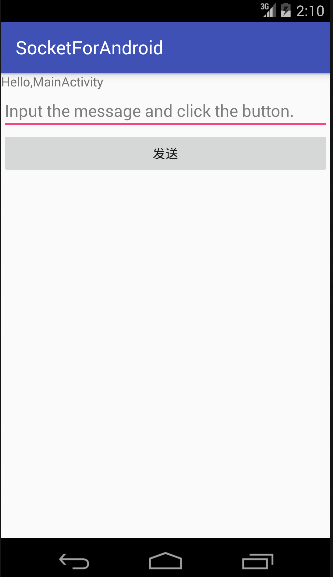
在输入框里输入如下字符串,点发送按钮:
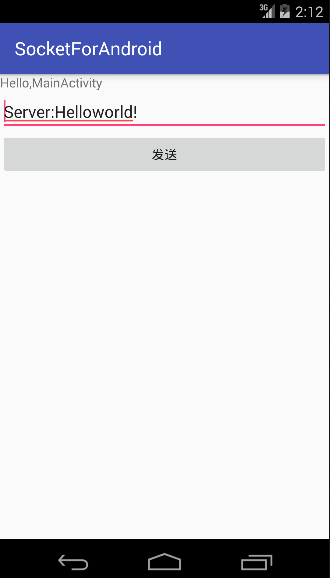
服务器收到客户端发来的消息并打印到控制台:

2、Apache接口
对于大部分应用程序而言JDK本身提供的网络功能已远远不够,这时就需要Android提供的Apache HttpClient了。它是一个开源项目,功能更加完善,为客户端的Http编程提供高效、最新、功能丰富的工具包支持。
下面我们以一个简单例子来看看如何使用HttpClient在Android客户端访问Web。
首先,要在你的机器上搭建一个web应用test,有两个很简单的PHP文件:hello_get.php和hello_post.php!
内容如下:
hello_get.php的代码如下:
<html> <body> Welcome <?php echo $_GET["name"]; ?><br> You connected this page on : <?php echo $_GET["get"]; ?> </body> </html>
hello_post.php的代码如下:
<html> <body> Welcome <?php echo $_POST["name"]; ?><br> You connected this page on : <?php echo $_POST["post"]; ?> </body> </html>
在原来的Android项目里新建一个Apache活动类:Apache.java,代码如下:
package com.yaowen.socketforandroid;
import android.os.Bundle;
import android.support.v7.app.AppCompatActivity;
import android.view.View;
import android.widget.Button;
import android.widget.TextView;
import org.apache.http.HttpEntity;
import org.apache.http.HttpResponse;
import org.apache.http.NameValuePair;
import org.apache.http.client.ClientProtocolException;
import org.apache.http.client.HttpClient;
import org.apache.http.client.entity.UrlEncodedFormEntity;
import org.apache.http.client.methods.HttpGet;
import org.apache.http.client.methods.HttpPost;
import org.apache.http.impl.client.DefaultHttpClient;
import org.apache.http.message.BasicNameValuePair;
import java.io.BufferedReader;
import java.io.IOException;
import java.io.InputStreamReader;
import java.io.UnsupportedEncodingException;
import java.util.ArrayList;
import java.util.List;
/**
* Created by YAOWEN on 2015/11/10.
*/
public class ApacheActivity extends AppCompatActivity implements View.OnClickListener {
private TextView textView;
private Button get1, post1;
@Override
protected void onCreate(Bundle savedInstanceState) {
super.onCreate(savedInstanceState);
setContentView(R.layout.apache);
textView = (TextView) findViewById(R.id.textView);
get1 = (Button) findViewById(R.id.get);
post1 = (Button) findViewById(R.id.post);
get1.setOnClickListener(this);
post1.setOnClickListener(this);
}
@Override
public void onClick(View v) {
if (v.getId() == R.id.get) {
//注意:此处ip不能用127.0.0.1或localhost,Android模拟器已将它自己作为了localhost
String url = "http://192.168.3.200/test/hello_get.php?name=yaowen&get=GET";
textView.setText(get(url));
}
if (v.getId() == R.id.post) {
String url="http://192.168.3.200/test/hello_post.php";
textView.setText(post(url));
}
}
/**
* 以post方式发送请求,访问web
*
* @param url web地址
* @return 响应数据
*/
private String post(String url) {
BufferedReader reader = null;
StringBuffer sb = null;
String result = "";
HttpClient client = new DefaultHttpClient();
HttpPost requset = new HttpPost(url);
//保存要传递的参数
List<NameValuePair> params = new ArrayList<NameValuePair>();
//添加参数
params.add(new BasicNameValuePair("name", "yaowen"));
params.add(new BasicNameValuePair("post","POST"));
try {
HttpEntity entity = new UrlEncodedFormEntity(params, "utf-8");
requset.setEntity(entity);
HttpResponse response = client.execute(requset);
if (response.getStatusLine().getStatusCode() == 200) {
System.out.println("post success");
reader = new BufferedReader(new InputStreamReader(response.getEntity().getContent()));
sb = new StringBuffer();
String line = "";
String NL = System.getProperty("line.separator");
while ((line = reader.readLine()) != null) {
sb.append(line);
}
}
} catch (UnsupportedEncodingException e) {
e.printStackTrace();
} catch (ClientProtocolException e) {
e.printStackTrace();
} catch (IOException e) {
e.printStackTrace();
} finally {
if (null != reader) {
try {
reader.close();
} catch (IOException e) {
e.printStackTrace();
}
}
if (null != sb) {
result = sb.toString();
}
}
return result;
}
/**
* 以get方式发送请求,访问web
*
* @param url web地址
* @return 响应数据
*/
private static String get(String url) {
BufferedReader bufferedReader = null;
StringBuffer sb = null;
String result = "";
HttpClient client = new DefaultHttpClient();
HttpGet request = new HttpGet(url);
//发送请求,得到响应
try {
HttpResponse response = client.execute(request);
//请求成功
if (response.getStatusLine().getStatusCode() == 200) {
bufferedReader = new BufferedReader(
new InputStreamReader(
response.getEntity()
.getContent()
)
);
sb = new StringBuffer();
String line = "";
String NL = System.getProperty("line.separator");
while ((line = bufferedReader.readLine()) != null) {
sb.append(line);
}
}
} catch (IOException e) {
e.printStackTrace();
} finally {
if (null != bufferedReader) {
try {
bufferedReader.close();
//bufferedReader=null;
} catch (IOException e) {
e.printStackTrace();
}
}
if (null != sb) {
result = sb.toString();
}
}
return result;
}
}
新建一个apache.XML文件,如下:
<?xml version="1.0" encoding="utf-8"?> <LinearLayout xmlns:android="http://schemas.android.com/apk/res/android" android:layout_width="fill_parent" android:layout_height="fill_parent" android:orientation="vertical"> <TextView android:id="@+id/textView" android:layout_width="fill_parent" android:layout_height="wrap_content" android:gravity="center" android:text="通过按钮选择不同方式访问网页" /> <Button android:id="@+id/get" android:layout_width="match_parent" android:layout_height="wrap_content" android:text="get" /> <Button android:id="@+id/post" android:layout_width="match_parent" android:layout_height="wrap_content" android:text="post" /> </LinearLayout>
结果运行如下:
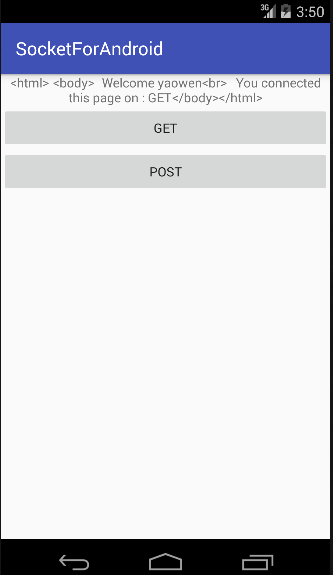
3.android.net编程:
常常使用此包下的类进行Android特有的网络编程,如:访问WiFi,访问Android联网信息,邮件等功能。
这里就不详细做例子了,因为这个接触比较多~~~。
下面给大家介绍Android的网络通讯
我们知道,Java提供的Socket可以完成了两台PC机的通信。TCPServer需要客户端和服务器,服务器用SocketServer和Socket完成,客户端使用Socket完成......这些我们都很熟悉。此章主要是通过TCPServer完成Android 与PC机的通信,
首先来看我们熟悉的服务器程序:
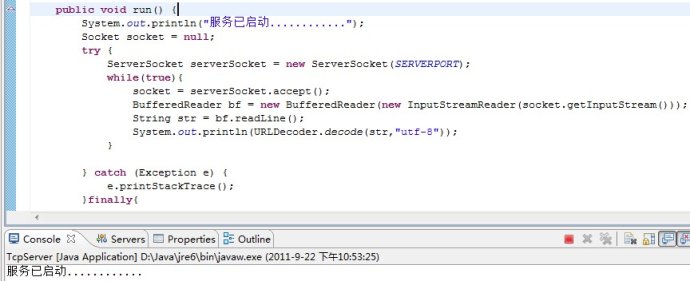
上图用主方法main其他一个Thread,然后在run方法里面无限监听发送过来的内容,如果有内容则输出。利用的是Java的API,很经典。
接下来就是在Android端发送数据给PC端,其代码如下:
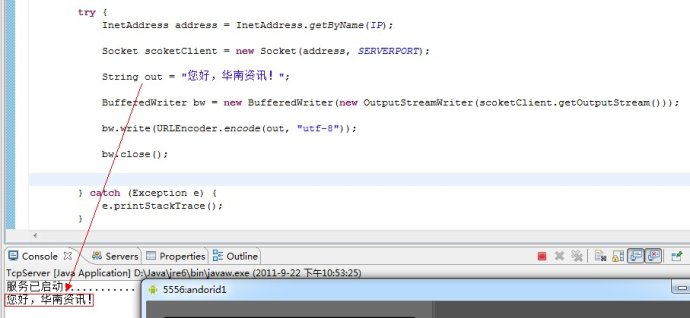
这样就完成了Android与PC机间的通信。
- 上一篇文章: Android编程之利用服务实现电话监听的方法
- 下一篇文章: 基于Android实现百度地图定位过程详解
- Android系统永不锁屏永不休眠的方法
- android指定DatePickerDialog样式并不显示年
- Android string.xml中的替换方法
- 用Eclipse搭建Android开发环境并创建第一个
- Android中用onSaveInstanceState保存Fragme
- 安卓(Android)动态创建多个按钮并添加监听
- 20.5 语音合成(百度2016年2月29日发布的tt